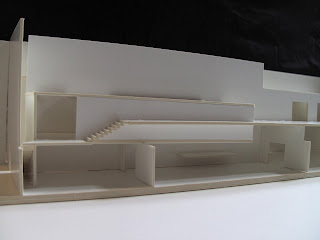I will attempt to briefly explain the concept behind this simplistic looking model.
Initially, when analysing Edward Hoppers Excursion into Philosophy the primary things I noticed were a melancholic looking man, deep in contemplation in a room with a window leaving a large patch of sunlight at his feet. I read some information on this work which suggested the man was contemplating Plato, life on earth and the afterlife. However, from this my narrative developed into something along the lines of:
A ROOM FOR A WRITER, STUCK IN SUBURBIA, SEARCHING FOR PURPOSE AND PERSPECTIVE.
Beyond my analysis of this work, I began to look at Hopper’s works in general and how the patches of light coming through the openings are painted as a solid colour, unlike in the Dutch paintings, and how they fill the room. I began to imagine these light patches as solid shapes, simultaneously polluting, and creating the bounds of the room. This is represented in my first concept model.
Taking this idea, I began to create the space out of simplistic shapes representing light/openings/program. My main focus was on shifting openings and degrees of transparency. So, at first the room is uninhabitable, there is no evidence of program – the solid light pollutes the room-this conveys my characters confusion and his fixed position in suburbia. Then as the openings shift, they become the program or reveal the program, and suddenly there are inhabitable spaces. Simultaneously, as these openings shift (can convey the passing of time and hence the characters contemplation and reaching resolution), new openings are created, and offer new perspectives outwards.
The function of windows and their role in creating program are some things I questioned.
I used plaster, resin and acetates of various thicknesses is exploring transparency.
I think this explains my thought process and the basics of what became a fairly conceptual model.

Concept Model 1

Concept Model 2
The Model:

This shows the 'polluted' room, uninhabitable








 above - some moments of contrast in the scheme
above - some moments of contrast in the scheme








 above - some moments of contrast in the scheme
above - some moments of contrast in the scheme



 Sphinx, 2009
Sphinx, 2009 Concept Model 1
Concept Model 1 Concept Model 2
Concept Model 2 This shows the 'polluted' room, uninhabitable
This shows the 'polluted' room, uninhabitable 
 The Openings/light shift and reveal the program. I imagined the plaster shape to the right as a private outdoor room, the left wall is louver-like windows, which move outwards to offer a bookcase internally. The back wall opening moves inwards to create a table, making a new opening in the wall.
The Openings/light shift and reveal the program. I imagined the plaster shape to the right as a private outdoor room, the left wall is louver-like windows, which move outwards to offer a bookcase internally. The back wall opening moves inwards to create a table, making a new opening in the wall. 

 The central stairs lead to an upper library level hosued in the resin block.
The central stairs lead to an upper library level hosued in the resin block.
